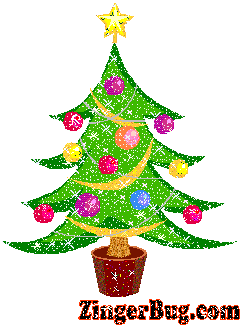
Comments by ZingerBug.com The Christmas tree is a decorated artificial or living tree, a popular tradition associated with the celebration of Christmas. Normally an evergreen coniferous tree that is brought into a home or used in the open, a Christmas tree is decorated with Christmas lights and colourful ornaments during the days around Christmas. An angel or star is often placed at the top of the tree, representing the host of angels or the Star of Bethlehem from the Nativity story.
--------------------------------------------------------------------------------
Tree trimming decorations:
A bauble decorating a Christmas treeTinsel and several types of garland or ribbon are commonly used to decorate a Christmas tree. Delicate mould-blown and painted coloured glass Christmas ornaments were a speciality of the glass factories in the Thuringian Forest especially in Lauscha in the late 19th century, and have since become a large industry, complete with famous-name designers. Lighting with candles or electric lights (fairy lights) is commonly done and a tree topper, traditionally either an angel or a star, completes the ensemble.
Silvered saran based tinsel was introduced later, which many have found to be unsatisfactory, since it did not drape well, leading to the demise of tinsel in tree decorating in the United States (it remains popular in many European countries). Baubles are another extremely common decoration, and usually consist of a fairly small hollow glass or plastic sphere coated with a thin metallic layer to make them reflective, and then with a further coating of a thin pigmented polymer in order to provide colouration.
Individuals' decorations vary widely, typically being an eclectic mix of family traditions and personal tastes; even a small unattractive ornament, if passed down from a parent or grandparent, may come to carry considerable emotional value and be given a place of pride on the tree. Conversely, trees decorated by professional designers for department stores and other institutions will usually have a "theme"; a set of predominant colours, multiple instances of each type of ornament, and larger decorations that may be more complicated to set up correctly. Some churches decorate with Chrismon trees, which use handmade ornaments depicting various Chrismon symbols. Chrismon means simple monograms of Jesus Christ.
Many people also decorate outdoor trees with food that birds and other wildlife will enjoy, such as garlands made from unsalted popcorn or cranberries, orange halves, and seed-covered suet cakes.
Tree mats and skirts:
Since candles were used to light trees until electric bulbs came about, a mat (UK) or "skirt" (US) was often placed on the floor below the tree to protect it by catching the dripping candle wax, and also to collect any needles that fall. Even when dripless candles, electric lights and artificial trees have been used, a skirt is still usually used as a decorative feature: among other things, it hides the Christmas tree stand, which may be unsightly but which is an important safety feature of home trees. What began as ordinary cloth has now often become much more ornate, some having embroidery or being put together like a quilt.
A nativity scene, model train, or Christmas village may be placed on the mat or skirt. As Christmas presents arrive, they are generally placed underneath the tree on the tree skirt (depending on tradition, all Christmas gifts, or those too large to be hung on the tree, as in "presents on the tree" of the song "I'll Be Home for Christmas").
Generally, the difference between a mat and skirt is simply that a mat is placed under the Christmas tree stand, while a skirt is placed over it, having a hole in the middle for the trunk, with a slot cut to the outside edge so that it can be placed around the tree (beneath the branches) easily. A plain mat of fabric or plastic may also be placed under the stand and skirt to protect the floor from scratches or water.
Christmas tree stand:
A Christmas tree stand is an object designed to support a cut, natural Christmas tree or an artificial Christmas tree. Christmas tree stands appeared as early as 1876 and have had various designs over the years. Those stands designed for natural trees have a water reservoir to hydrate the live tree.
Flocking
In the 1940s and 1950s flocking was very popular on the West Coast of the United States. There were home flocking kits that could be used with vacuum cleaners. In the 1980s some trees were sprayed with fluffy white flocking to simulate snow. Typically it would be sprayed all over the tree from the sides, which produced a look different from real snow, which settles in clumps atop branches. Flocking can be done with a professional sprayer at a tree lot (or the manufacturer if it is artificial), or at home from a spray can, and either can be rather messy. This tradition seems to be most popular on the West Coast and Southern parts of the United States.
Because flock contains flame retardants, a flocked tree can be placed in a public building in accordance with local fire codes.
Wikipedia










